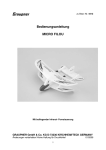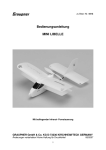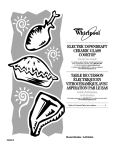Download Notice - Graupner
Transcript
zu Best.-Nr. 4409 JUNIOR LINE Bedienungsanleitung NANO STAR 2 GYRO Mit beiliegender Infrarot-Fernsteuerung Miniatur-Fun-Helikopter für Indoorbetrieb, frei fliegend, mit Steuerung über 3 Funktionen GRAUPNER GmbH & Co. KG D-73230 KIRCHHEIM/TECK GERMANY Änderungen vorbehalten! Keine Haftung für Druckfehler! 03/2010 1 Vorwort Der GRAUPNER RC-Heli NANO STAR 2 GYRO ist ein Indoorflugmodell. Der Heli ist fertig gebaut, incl. Motoren, Drehzahlstellern und Li-Po-Akku. Der Flugakku befindet sich im Rumpf. Im Sender (IR) ist ein Ladegerät integriert. Es müssen nur Batterien in den Sender eingelegt werden, Flugakku laden und der Flugspass kann los gehen. Beim Modell NANO STAR 2 GYRO handelt es sich um ein kleines Elektro-RCHubschraubermodell für Jugendliche über 14 Jahren, bei Jugendlichen unter 14 Jahren muss der Betrieb des Modells von einem Erwachsenen beaufsichtigt werden. Bitte beachten Sie die Sicherheitsvorschriften am Ende der Bedienungsanleitung Fernsteuerung für NANO STAR 2 GYRO 1. 2. 3. 4. 5. Infrarot-Fernsteuerung im Baukasten enthalten Senderbatterie 6 x 1,5V Mignon (AA) im Baukasten enthalten (Ersatzbatterien Best.-Nr. 3426) Hubschrauberakku 3,7 V 100 mAh LiPo Akku Antriebsakku wird durch das Ladekabel im Sender geladen oder durch das USB-Ladekabel Senderbatterien 1. 2. 3. 4. Sender einschalten. Neue Batterien sind notwendig, wenn die LEDAnzeige pulsiert. Sicherstellen, dass die Batterien polungsrichtig eingesetzt werden Niemals neue mit alten Batterien mischen. Niemals verschiedene Batteriefabrikate einsetzen. GRAUPNER GmbH & Co. KG D-73230 KIRCHHEIM/TECK GERMANY Änderungen vorbehalten! Keine Haftung für Druckfehler! 03/2010 2 Akku laden 1. 2. 3. 4. • • • • • Hubschrauber zuerst ausschalten Ladekabel des Senders (unten im Sender ) in die Ladebuchse des Hubschraubers einstecken. Sender einschalten: Anzeige leuchtet rot. Die Anzeige wird grün, sobald der Akku vollgeladen ist, dann Stecker abziehen. Ladevorgang dauert so ca. 40-50 Minuten Hubschrauberakku niemals auf bzw. neben einen heißen Gegenstand bringen (offene Flammen, Heizkörper), um der Explosionsgefahr vorzubeugen. Hubschrauberakku trocken lagern. Hubschrauberakku niemals mit einem harten Gegenstand schlagen, um Schäden zu vermeiden. Akku nicht zerlegen. Der Akku darf niemals unbeaufsichtigt geladen werden. Während des Ladevorgangs muss der Schalter des Hubschraubers auf OFF (AUS) stehen. GRAUPNER GmbH & Co. KG D-73230 KIRCHHEIM/TECK GERMANY Änderungen vorbehalten! Keine Haftung für Druckfehler! 03/2010 3 5. Akku kann auch über des mitgelieferte USB – Ladekabel über den PC geladen werden. Ladekabel in PC USB – Buchse stecken, im Stecker leuchtet rote LED. Gegenstück in Hubschrauber- Ladebuchse stecken, LED geht aus, wenn Akku voll ist ca. 40- 50 Minuten leuchtet LED im Stecker und es muss abgesteckt werden. Beim Laden immer Schalter am Heli auf AUS (OFF) stellen. RC-Funktionen Steigen Wenn der linke Knüppel (Gasknüppel) langsam nach vorne geschoben wird, beschleunigen die Hauptrotorblätter, der Hubschrauber fängt an zu steigen. Sinken Wenn der linke Knüppel (Gasknüppel) nach hinten gezogen wird, verlangsamen sich die Hauptrotorblätter, der Hubschrauber fängt an zu sinken. Nase nach links Wenn der rechte Knüppel (Seitenruderknüppel) nach links bewegt wird, dreht die Nase des Hubschraubers nach links. Nase nach rechts Wenn der rechte Knüppel (Seitenruderknüppel) nach rechts bewegt wird, dreht die Nase des Hubschraubers nach rechts. GRAUPNER GmbH & Co. KG D-73230 KIRCHHEIM/TECK GERMANY Änderungen vorbehalten! Keine Haftung für Druckfehler! 03/2010 4 Vorwärts Wenn der rechte Knüppel nach vorne geschoben wird, fliegt der Hubschrauber vorwärts. Rückwärts Wenn der rechte Knüppel nach hinten gezogen wird, fliegt der Hubschrauber rückwärts. Sonderhinweise 1. Wenn sich der Hubschrauber beim Schweben dreht, Trimmung gegen die Drehrichtung drehen bis der Heli steht. 2. 3. Wenn die Batterien des Senders beinahe erschöpft sind, fängt LEDAnzeige an zu pulsieren, jetzt Batterien wechseln Der Heli kann auf 2 verschiedenen Kanälen (A oder B) geflogen werden. Kanal auswählen, Sender einschalten, Heli einschalten, wenn LED auf Platine im Rumpf leuchtet kann geflogen werden. GRAUPNER GmbH & Co. KG D-73230 KIRCHHEIM/TECK GERMANY Änderungen vorbehalten! Keine Haftung für Druckfehler! 03/2010 5 Fliegen 1. 2. 3. 4. 5. 6. 7. Kanalwahlschalter am Sender auf entsprechende Kanal A oder B einstellen. Sender einschalten, LED am Sender leuchtet grün Hubschrauber einschalten (on), LED auf Platine im Rumpf hinten links blinkt, wenn LED konstant leuchtet ist Heli flugbereit. Sender (blaue Kappe) immer Richtung Heli richten Hubschrauber auf ebenen Boden stellen, noch einmal prüfen ob sich Menschen, Tiere oder andere Hindernisse in der Nähe befinden. Gasknüppel langsam vorwärts schieben: der Hubschrauber steigt. Mit dem Trimmregler Heli austrimmen und mit den Steuerknüppeln Modell entsprechend steuern. Steuerung von Steig-, Sink- und Schwebeflug NANO STAR 2 GYRO bringt den größten Flugspass, wenn er in einen stabilen, ruhigen Schwebeflug gebracht wird. Nach entsprechender Übung kann das Modell ähnlich einem Modellhubschrauber über die Mehrkanalsteuerung bewegt werden: Nach Erreichen der gewünschten Flughöhe muss der linke Steuerknüppel (Steigen/Sinken) möglichst ruhig in der Position gehalten werden, in der das Modell weder steigt noch sinkt. Mit der Trimmung wird jede unerwünschte Drehung des Modells entgegengesteuert, so dass ein stabiler Schwebeflug erreicht wird. Wenn es erreicht ist, dass der NANO STAR 2 GYRO in der gewünschten Höhe schwebt, ohne sich zu drehen, kann mit der Richtungssteuerung die Ausrichtung des Rumpfes (und damit die mögliche Flugrichtung) bewusst gesteuert werden. Mit der Vorwärts/Rückwärts-Steuerung kann dann in diese Richtung beschleunigt oder abgebremst und auch langsam rückwärts geflogen werden. Mit der Kombination aller Steuerfunktionen kann das Modell also ähnlich einem richtigen Hubschrauber geflogen werden. GRAUPNER GmbH & Co. KG D-73230 KIRCHHEIM/TECK GERMANY Änderungen vorbehalten! Keine Haftung für Druckfehler! 03/2010 6 Landung und Beenden des Flugbetriebs Das Landen des NANO STAR 2 GYRO erfolgt einfach durch vorsichtiges Zurückziehen des linken Steuerknüppels. Nach der Landung zuerst den Hauptschalter am Modell in die „OFF“- Position bringen, danach den Sender ausschalten. Hinweis: Gegen Ende des Fluges wird das Flugverhalten aufgrund der nachlassenden Akkuspannung instabil. In diesem Fall muss gelandet und der Akku aufgeladen werden. Beheben von Störungen • Nach der ersten Ladung besitzt der Flugakku u.U. noch nicht die volle Kapazität, was zu einer verringerten Flugzeit führt. Die volle Leistung erreicht der Akku nach einigen Lade- und Entladezyklen. Nach dem Flugbetrieb • Nach Beenden des Flugbetriebes sollte das Modell wieder in seine Originalverpackung eingesetzt werden, um ein Verbiegen oder Verziehen der Rotoren zu vermeiden. • Wenn das Modell längere Zeit nicht benutzt werden soll muss sichergestellt werden, dass das Modell ausgeschaltet ist und die Batterien aus dem Sender entnommen sind. Wir wünschen Ihnen viel Spaß und Freude beim Fliegen mit Ihrem NANO STAR 2 GYRO JUNIOR LINE Ihr Team ! GRAUPNER GmbH & Co. KG D-73230 KIRCHHEIM/TECK GERMANY Änderungen vorbehalten! Keine Haftung für Druckfehler! 03/2010 7 Sicherheitsvorschriften Wichtige Sicherheitshinweise Sie haben ein Modell mit Infrarot- Fernsteuerung erworben. Die Einhaltung der Betriebsanleitung im Zusammenhang mit dem Modell sowie die Installation, der Betrieb, die Verwendung und Wartung der mit dem Modell zusammenhängenden Komponenten können von GRAUPNER nicht überwacht werden. Daher übernimmt GRAUPNER keinerlei Haftung für Verluste, Schäden oder Kosten, die sich aus dem fehlerhaften Betrieb, aus fehlerhaftem Verhalten bzw. in irgendeiner Weise mit dem Vorgenannten zusammenhängend ergeben. Soweit vom Gesetzgeber nicht zwingend vorgeschrieben, ist die Verpflichtung der Firma GRAUPNER zur Leistung von Schadensersatz, aus welchem Grund auch immer ausgeschlossen (inkl. Personenschäden, Tod, Beschädigung von Gebäuden sowie auch Schäden durch Umsatz- oder Geschäftsverlust, durch Geschäftsunterbrechung oder andere indirekte oder direkte Folgeschäden), die von dem Einsatz des Modells herrühren. Die Gesamthaftung ist unter allen Umständen und in jedem Fall beschränkt auf den Betrag, den Sie tatsächlich für dieses Modell gezahlt haben. Die Inbetriebnahme und der Betrieb des Modells erfolgt einzig und allein auf Gefahr des Betreibers. Nur ein vorsichtiger und überlegter Umgang beim Betrieb schützt vor Personen- und Sachschäden. Nach der neuen Regelung des §103 Abs. 3 LuftVZO müssen alle Flugmodelle, egal ob Slowflyer, Parkflyer, Segelflugzeuge, Flugmodelle mit Antrieben jeglicher Art vor Aufnahme des Flugbetriebs versichert sein. Schließen Sie daher eine spezielle RC-Modell-Haftpflichtversicherung ab. Fragen hierzu, werden Ihnen vom Fachhandel gerne beantwortet. Diese Sicherheitshinweise müssen unbedingt aufbewahrt und bei einem Weiterverkauf des Modells an den Käufer weitergegeben werden. • • • • Vor Inbetriebnahme alle Warn- und Sicherheitshinweise in dieser Anleitung und auf der Verpackung lesen und beachten. Der Verbraucher ist verantwortlich, körperliche Verletzungen bzw. Sachschäden durch die Verwendung des Hubschraubers zu vermeiden. Der Hubschrauber muss gemäß der Anleitung behandelt werden. Um Verletzungen zu vermeiden, sind Finger, Kopf bzw. Körper vor den sich drehenden Bauteilen wegzuhalten. Der Verbraucher ist verantwortlich, mit dem Hubschrauber sicher umzugehen. Der Hersteller bzw. der Vertreiber haftet nicht, wenn Verluste bzw. Schäden durch unsachgemäße Anwendung verursacht werden. GRAUPNER GmbH & Co. KG D-73230 KIRCHHEIM/TECK GERMANY Änderungen vorbehalten! Keine Haftung für Druckfehler! 03/2010 8 • • Dieses Produkt eignet sich für Jugendliche ab 14 Jahren und mehr. Jüngere Personen dürfen nur unter der Aufsicht von Erwachsenen damit spielen. Sie allein sind für einen gefahrlosen Betrieb verantwortlich! Warnhinweise 1. Der Satz enthält kleine Teile, die beim Verschlucken gesundheitliche Schäden verursachen können; sie müssen daher von Kindern unter 3 Jahren ferngehalten werden. 2. Nicht in Betrieb setzen, wenn schon ein anderes ferngesteuertes Modell auf demselben Kanal betrieben wird (der Kanal (A-B) wird am Sender eingestellt. 3. Das Modell nicht im Freien betreiben. Stets in einem Bereich ohne Hindernisse fliegen. 4. Stets sicherstellen, dass nur frische bzw. voll aufgeladene Stromquellen verwendet werden. 5. Keine der gelieferten Teile auseinandernehmen oder verändern, das gilt besonders für Sender und Flugakku. 6. Keine Feuchtigkeit in die Komponenten eindringen lassen, andernfalls kann die Elektronik beschädigt werden. 7. Darauf achten, dass weder Finger, noch Haare oder lose Kleidung in die Rotoren gerät. 8. Das Modell bei Nichtgebrauch stets ausschalten. 9. Flugakku nicht ausbauen, großer Hitze aussetzen oder ins Feuer werfen. 10. Nur den mitgelieferten Sender mit integriertem Ladegerät verwenden. 11. Oder laden über USB – Ladekabel am PC 12. Aufsicht durch Erwachsene wird empfohlen, Kinder müssen auf mögliche Gefahren beim Umgang mit dem Modell hingewiesen werden Sicherheitshinweise für Stromquellen • Es darf nicht versucht werden, nichtwiederaufladbare Batterien aufzuladen. • Wiederaufladbare Batterien sind zum Laden aus dem Gerät zu entnehmen, sofern in der Anleitung nicht ausdrücklich etwas anderes bestimmt wird. • Wiederaufladbare Batterien dürfen nur unter Aufsicht Erwachsener aufgeladen werden. • Weder unterschiedliche Batterietypen, noch neue und gebrauchte Batterien gemeinsam miteinander verwenden. • Nur Batterien verwenden, die dem empfohlenen Typ entsprechen oder gleichwertig sind. GRAUPNER GmbH & Co. KG D-73230 KIRCHHEIM/TECK GERMANY Änderungen vorbehalten! Keine Haftung für Druckfehler! 03/2010 9 • • • • Batterien nur mit der korrekten Polarität einsetzen. Verbrauchte Batterien sofort aus den Geräten entnehmen. Anschlüsse nicht kurzschließen. Verwenden Sie niemals defekte, beschädigte Zellen oder Batterien mit unterschiedlichen Zellentypen. Sicherheitshinweise 1. Die Steuerung des Modells erfolgt über Infrarot (Licht). Daher muss bei direkter Sonneneinstrahlung, ebenso wie beim Flug unter starken Leuchtstofflampen, mit einer Beeinträchtigung der Steuerung und Störungen gerechnet werden. 2. Aufgrund seines geringen Gewichts reagiert das Modelle empfindlich auf Wind; daher nur in geschlossenen Räumen fliegen, ohne den Einfluss von Wind. Auch die Luftströmungen von Klimaanlagen können sich negativ auf das Flugverhalten auswirken. 3. Der ins Modell integrierte Lithium-Polymer-Akku enthält gesundheitsschädliche Chemikalien; er darf daher weder ausgebaut, noch geöffnet werden. 4. Der Ladevorgang sollte unter Aufsicht von Erwachsenen durchgeführt werden, wobei Kinder möglichst fern zu halten sind. 5. Falls die Rotoren beschädigt oder gebrochen sind, nicht versuchen, das Modell weiter zu betreiben, um ein Verletzungsrisiko auszuschließen. 6. Nicht versuchen, das Modell zu öffnen oder die Konstruktion zu verändern. 7. Der Flugbetrieb erfordert einen freien Raum von ca. 4 x 4 x 2,5 m ohne Hindernisse. Modell nicht dicht an Menschen, Tiere, Möbeln oder anderen Hindernissen fliegen. 8. Der Betreiber muss im Besitz seiner vollen körperlichen und geistigen Fähigkeiten sein. Wie beim Autofahren, ist der Betrieb des Flugmodells unter Alkohol oder Drogeneinwirkung nicht erlaubt. Herstellererklärung Fa. Graupner GmbH & Co KG, Henriettenstr. 94 -96, D 73230 Kirchheim/Teck Inhalt der Herstellererklärung: Sollten sich Mängel an Material oder Verarbeitung an einem von uns in der Bundesrepublik Deutschland vertriebenen, durch einen Verbraucher (§ 13 BGB) erworbenen Gegenstand zeigen, übernehmen wir, die Fa. Graupner GmbH & Co KG, Kirchheim/Teck im nachstehenden Umfang die Mängelbeseitigung für den Gegenstand. GRAUPNER GmbH & Co. KG D-73230 KIRCHHEIM/TECK GERMANY Änderungen vorbehalten! Keine Haftung für Druckfehler! 03/2010 10 Rechte aus dieser Herstellererklärung kann der Verbraucher nicht geltend machen, wenn die Beeinträchtigung der Brauchbarkeit des Gegenstandes auf natürlicher Abnutzung, Einsatz unter Wettbewerbsbedingungen, unsachgemäßer Verwendung (einschließlich Einbau) oder Einwirkung von außen beruht. Diese Herstellererklärung lässt die gesetzlichen oder vertraglich eingeräumten Mängelansprüche und –rechte des Verbrauchers aus dem Kaufvertrag gegenüber seinem Verkäufer (Händler) unberührt. Umfang der Garantieleistung Im Garantiefall leisten wir nach unserer Wahl Reparatur oder Ersatz der mangelbehafteten Ware. Weitergehende Ansprüche, insbesondere Ansprüche auf Erstattung von Kosten im Zusammenhang mit dem Mangel (z.B. Ein/Ausbaukosten) und der Ersatz von Folgeschäden sind – soweit gesetzlich zugelassen – ausgeschlossen. Ansprüche aus gesetzlichen Regelungen, insbesondere nach dem Produkthaftungsgesetz, werden hierdurch nicht berührt. Voraussetzung der Garantieleistung Der Käufer hat den Garantieanspruch schriftlich unter Beifügung des Originals des Kaufbelegs (z.B. Rechnung, Quittung, Lieferschein) und dieser Garantiekarte geltend zu machen. Er hat zudem die defekte Ware auf seine Kosten an die o.g. Adresse einzusenden. Die Einsendung hat an folgende Adresse zu erfolgen: Fa. Graupner GmbH & CO KG, Serviceabteilung, Henriettenstr.94 -96, D 73230 Kirchheim/Teck Der Käufer soll dabei den Material- oder Verarbeitungsfehler oder die Symptome des Fehlers so konkret benennen, dass eine Überprüfung unserer Garantiepflicht möglich wird. Der Transport des Gegenstandes vom Verbraucher zu uns als auch der Rücktransport erfolgen auf Gefahr des Verbrauchers. Gültigkeitsdauer Diese Erklärung ist nur für während der Anspruchsfrist bei uns geltend gemachten Ansprüche aus dieser Erklärung gültig. Die Anspruchsfrist beträgt 24 Monate ab Kauf des Gerätes durch den Verbraucher bei einem Händler in der Bundesrepublik Deutschland (Kaufdatum). Werden Mängel nach Ablauf der Anspruchsfrist angezeigt oder die zur Geltendmachung von Mängeln nach dieser Erklärung geforderten Nachweise oder Dokumente erst nach Ablauf der Anspruchsfrist vorgelegt, so stehen dem Käufer keine Rechte oder Ansprüche aus dieser Erklärung zu. GRAUPNER GmbH & Co. KG D-73230 KIRCHHEIM/TECK GERMANY Änderungen vorbehalten! Keine Haftung für Druckfehler! 03/2010 11 Verjährung Soweit wir einen innerhalb der Anspruchsfrist ordnungsgemäß geltend gemachten Anspruch aus dieser Erklärung nicht anerkenne, verjähren sämtliche Ansprüche aus dieser Erklärung in 6 Monaten vom Zeitpunkt der Geltendmachung an, jedoch nicht vor Ende der Anspruchsfrist. Anwendbares Recht Auf diese Erklärung und die sich daraus ergebenden Ansprüche, Rechte und Pflichten findet ausschließlich das materielle deutsche Recht ohne die Normen des Internationalen Privatrechts sowie unter Ausschluss des UN-Kaufrechts Anwendung. Pflege und Wartung • Säubern Sie das Modell nach jedem Gebrauch. • Säubern Sie das Modell und die RC-Komponenten nur mit geeigneten Reinigungsmitteln. Informieren Sie sich hierzu bei Ihrem Fachhändler. Die Montage und (Reparaturanleitung) Sorgen Sie bei Klebstoffen mit Lösungsmitteln für einen gut belüfteten Raum. Geben Sie Klebstoff- und Farbreste bei Sondermüllsammelstellen ab. Eine großzügig bemessene freie Arbeitsfläche ist bei allen Bastelarbeiten von besonderem Vorteil. Nicht im Freien fliegen Überprüfung vor dem Start Sind mehrere Helis im Einsatz, vergewissern Sie sich vorher davon, dass Sie als einziger auf Ihrem Kanal senden, ehe Sie Ihren eigenen Sender einschalten. Die Doppelbelegung eines Frequenzkanals verursacht Störungen oder kann andere Modelle zum Absturz bringen. Vor jedem Start kontrollieren, dass alle Teile einwandfrei montiert sind. Der Heli muss immer so gehalten werden, dass die Rotoren sich frei drehen können, denn diese können zu Verletzungen führen. Immer zuerst Sender einschalten, dann erst Empfänger einschalten. Immer zuerst Empfänger ausschalten, dann erst Sender ausschalten. GRAUPNER GmbH & Co. KG D-73230 KIRCHHEIM/TECK GERMANY Änderungen vorbehalten! Keine Haftung für Druckfehler! 03/2010 12 Wenn diese Reihenfolge nicht eingehalten wird, also der Empfänger eingeschaltet ist, der dazugehörige Sender jedoch auf „AUS“, so kann der Empfänger durch andere Sender, Störungen usw. zum Ansprechen gebracht werden. Der Motor könnte anlaufen. Vor jedem Einsatz korrekte Funktion und Reichweite (ca. 15 m) überprüfen. Dazu aus entsprechendem Abstand vom Modell kontrollieren, ob alle Funktionen einwandfrei sind. Die Motoren erwärmen sich während bzw. nach dem Flug stark. Motoren erst berühren, wenn sie wieder auf Zimmertemperatur abgekühlt sind. Motor zu heiß Warnung: niemals das Modell in einer klimatisierten Halle mit Luftgebläse fliegen; das gleicht einem starken Wind, der das Flugmodell außerhalb der Reichweite bzw. außer Kontrolle geraten lässt. Flugzeit: bei vollgeladenem Akku fliegt der Hubschrauber bei windlosen Bedingungen ungefähr 5 bis 8 Minuten. Wenn das Modell nur ungern startet bzw. steigt, sollte der Flugakku aufgeladen werden. Entsorgung Flugakku leer fliegen oder Rotor solange laufenlassen bis er sich nicht mehr dreht. Kanzel abschrauben und entfernen. Kabel am Akku einzeln durchtrennen (Kurzschlussgefahr), einzeln isolieren, Akku entnehmen und fachgerecht entsorgen GRAUPNER GmbH & Co. KG D-73230 KIRCHHEIM/TECK GERMANY Änderungen vorbehalten! Keine Haftung für Druckfehler! 03/2010 13 Hinweise zum Umweltschutz Wichtiger Entsorgungshinweis zu Batterien und Akkus: Jeder Verbraucher ist nach der deutschen Batterieverordnung gesetzlich zur Rückgabe aller gebrauchten und verbrauchten Batterien bzw. Akkus verpflichtet. Eine Entsorgung über den Hausmüll ist verboten. Alte Batterien und Akkus können unentgeltlich bei den öffentlichen Sammelstellen der Gemeinde, in unseren Verkaufsstellen und überall dort abgegeben werden, wo Batterien und Akkus der betreffenden Art verkauft werden. Sie können die von uns gelieferten Batterien ausreichend frankiert auch nach Gebrauch an folgende Adresse zurücksenden: Graupner GmbH & Co. KG Service: Gebrauchte Batterien Henriettenstr. 94-96 73230 Kirchheim unter Teck Deutschland Sie leisten damit einen wesentlichen Beitrag zum Umweltschutz! Schadstoffhaltige Batterien bzw. Akkus sind mit den folgenden Symbolen gekennzeichnet, um auf das Hausmüll-Entsorgungsverbot hinzuweisen. Unter dem Zeichen ist das chemische Symbol für das Schwermetall angegeben: Cd Hg Pb Batterie enthält: 1) Cd: Cadmium 2) Hg: Quecksilber 3) Pb: Blei Hinweise zum Umweltschutz Das Symbol auf dem Produkt, der Gebrauchsanleitung oder der Verpackung weist darauf hin, dass dieses Produkt am Ende seiner Lebensdauer nicht über den normalen Haushaltsabfall entsorgt werden darf. Es muss an einem Sammelpunkt für das Recycling von elektrischen und elektronischen Geräten abgegeben werden. Die Werkstoffe sind gemäß ihrer Kennzeichnung wiederverwertbar. Mit der Wiederverwendung, der stofflichen Verwertung oder anderen Formen der Verwertung von Altgeräten leisten Sie einen wichtigen Beitrag zum Umweltschutz. Batterien und Akkus müssen aus dem Gerät entfernt werden und bei einer entsprechenden Sammelstelle getrennt entsorgt werden. Bitte erkundigen Sie sich bei der Gemeindeverwaltung die zuständige Entsorgungsstelle. GRAUPNER GmbH & Co. KG D-73230 KIRCHHEIM/TECK GERMANY Änderungen vorbehalten! Keine Haftung für Druckfehler! 03/2010 14 Order No. 4409 JUNIOR LINE Operating Instructions NANO STAR 2 GYRO Miniature Fun Helicopter complete with Infra-Red remote control system for untethered indoor flying with three-function remote control Foreword The GRAUPNER NANO STAR 2 GYRO is a remote-controlled indoor model helicopter. The model is supplied factory-assembled, including motors, speed controllers and LiPo battery; the flight battery is already installed in the fuselage. All you have to do is fit dry cells in the (IR) transmitter and charge the flight battery, and the flying fun can commence. The NANO STAR 2 GYRO is a small electric-powered remote-controlled model helicopter intended for youngsters of fourteen years and over. If young persons under fourteen years wish to fly the model, an adult must supervise the activity. Please read and observe the sate notes at the end of the operating instructions. NANO STAR 2 GYRO remote control system 1. 2. 3. 4. 5. The infra-red remote control system is included in the set. 6 x 1.5 V AA-sized dry cells are included in the kit (replacement Order No. 3426) Helicopter battery: 3.7 V / 100 mAh LiPo The helicopter battery is recharged via the transmitter or via the USB lead Transmitter batteries 1. 2. 3. 4. 5. Switch the transmitter on. If the red LED flashes, new cells are required. Insert the cells in the transmitter compartment with correct polarity. Ensure that the battery cells are fitted with correct polarity. Never mix new and old cells. Never fit different makes of battery cell. GRAUPNER GmbH & Co. KG D-73230 KIRCHHEIM/TECK GERMANY Änderungen vorbehalten! Keine Haftung für Druckfehler! 03/2010 15 Charging the battery 1. 2. 3. 4. • • • • • First switch the helicopter off. Locate the charge lead in the back panel of the transmitter, and insert the charge connector into the helicopter socket. Switch the transmitter on, and the LED will light up red. The LED glows green when the battery is fully charged. Disconnect the charge lead at this point. This method of charging takes about 40 to 50 minutes. Never allow the helicopter battery to touch or come close to any hot object (open flame, heating radiator), otherwise there is a risk of explosion. Store the helicopter battery in dry indoor conditions. Never strike the battery with a hard object, as this could damage the cell. Do not dismantle the LiPo battery. The battery should never be left on charge unsupervised. During the charge process the switch on the helicopter must be left at the OFF position. 5. The battery can also be recharged from a PC using the USB charge lead supplied in the set: connect the charge lead to the USB socket of a PC, and the LED in the plug will glow red. Insert the other end of the lead in the helicopter charge socket, and the LED will go out. After about 40 to 50 minutes, when the battery is fully charged, the LED in the plug will light up, and the charge lead must be disconnected. During the charge process the switch on the helicopter must be left at the OFF position. Remote control functions Climb If you slowly move the left-hand stick (throttle stick) forward (away from you), the main rotor blades will start to rotate and accelerate steadily; the helicopter takes off and climbs. Descent If you move the left-hand stick (throttle stick) back (towards you), the main rotor blades slow down; the helicopter starts to descend. Nose left If you move the right-hand stick (rudder stick) to the left, the helicopter’s nose moves to the left. Nose right If you move the right-hand stick (rudder stick) to the right, the helicopter’s nose moves to the right. Forward If you move the right-hand stick forward (away from you), the helicopter flies forward. Back If you move the right-hand stick back (towards you), the helicopter flies backwards. GRAUPNER GmbH & Co. KG D-73230 KIRCHHEIM/TECK GERMANY Änderungen vorbehalten! Keine Haftung für Druckfehler! 03/2010 16 Special notes 1. If you find that the model’s nose constantly turns in one direction, turn the trim knob in the opposite direction until the rotation ceases. 2. When the transmitter cells are almost exhausted, the LED starts flashing. This is the time to change the batteries. 3. The helicopter can be operated on two different channels (A or B). Select the channel, switch the transmitter on, then switch the helicopter on; if the LED on the circuit board in the fuselage lights up, you can start flying. Stabilisierungsstange Hauptrotorblatt Heckrotorblatt Landegestell LED Kanalwahl Ein/Aus-Schalter Gasknueppel Seitenruderknueppel Trimmung Ladebuchse Ein/Aus Schalter Flybar Main rotor blade Tail rotor blade Landing gear LED Channel select On / Off switch Throttle stick Rudder stick Trim Charge socket On / Off switch Flying the model 1. Set the channel select switch on the transmitter to channel A or B as required. 2. Switch the transmitter on: the LED lights up green. 3. Switch the helicopter on (ON): the LED on the circuit board (rear left of the fuselage) flashes; when the LED glows constantly, the helicopter is ready to fly. 4. Keep the blue dome of the transmitter pointing at the helicopter at all times. 5. Place the model on a flat floor, and check once more that there are no people, animals or other obstacles close by. 6. Slowly move the throttle stick forward: the helicopter lifts off and climbs. 7. If necessary, turn the trim knob to trim the helicopter, then use the sticks to control the model. Controlling climb, descent and hovering The first step in getting maximum fun out of the NANO STAR 2 GYRO is to establish a stable, smooth hover. After a little practice the multi-channel control system can be used to fly the model in a similar manner to a “proper” model helicopter: When the machine reaches the desired altitude, hold the left-hand stick (climb / descent) as still as possible in the position where the helicopter neither climbs nor descends. If the model starts turning in either direction, use the right-hand stick to counteract the movement; in this way you will soon achieve a steady hover. Once you have learned the skill of keeping the NANO STAR 2 GYRO hovering at a particular height, without rotating, you can deliberately alter the orientation of the fuselage (and therefore the possible direction of flight) using the direction control (right stick). The forward / back control (right stick again) is used to accelerate or brake the model in this direction; the helicopter is even capable of flying slowly backwards. By combining all the stick functions the model can be controlled in a similar manner to a ‘real’ helicopter. GRAUPNER GmbH & Co. KG D-73230 KIRCHHEIM/TECK GERMANY Änderungen vorbehalten! Keine Haftung für Druckfehler! 03/2010 17 Landing, terminating flight operations The NANO STAR 2 GYRO can be landed simply by gradually moving the left-hand stick back towards you. After the landing the main switch on the model must first be moved to the “OFF” position, and only then the transmitter can be switched off. Note: towards the end of a flight the model will become increasingly unstable due to the declining battery voltage. When this happens you must land the model and recharge the battery. Fault-finding • After the initial charge you may find that the flight battery does not give its full capacity, resulting in reduced flight times. The LiPo pack only reaches its full performance after a few charge / discharge cycles. After a flying session • At the end of a flying session the model should be replaced in its original packaging to avoid the danger of accidentally bending or distorting the rotors. • If you know you will not be flying the helicopter for a long period, ensure that the model is switched off, and remove the dry cells from the transmitter. We wish you loads of fun and pleasure flying your NANO STAR 2 GYRO Yours - the Graupner JUNIOR LINE team! Safety Regulations Important safety notes You have acquired a model helicopter with an infra-red remote control system. However, we as manufacturers have no control over the way you build and operate your RC model aircraft, nor how you install, operate and maintain the associated components, and for this reason we are obliged to deny all liability for loss, damage or costs which are incurred due to the incorrect use of our products or due to incompetent behaviour on the part of the user, or which are connected with such operation in any way. Unless otherwise prescribed by binding law, the obligation of the GRAUPNER company to pay compensation, regardless of the legal argument employed, is excluded. This includes personal injury, death, damage to buildings, damages due to loss of business or turnover, interruption of business or other direct or indirect consequent damage whose root cause was the operation of the model. The total liability in all cases and under all circumstances is limited to the amount of money which you actually paid for the model. This model is operated at the sole and express responsibility of the operator. The only way to avoid injury to persons and damage to property is to handle and operate the model with the greatest care and consideration at all times. According to the new regulation of §103 Paragraph 3 of the LuftVZO (German Aviation Approvals Office), all model aircraft - whether slow-flyer, park-flyer, glider, or model aircraft propelled by any form of power plant - must be insured before the model is operated. If you GRAUPNER GmbH & Co. KG D-73230 KIRCHHEIM/TECK GERMANY Änderungen vorbehalten! Keine Haftung für Druckfehler! 03/2010 18 are not sure about this, please ask at your local model shop where the staff will be glad to advise you. These safety notes must be kept in a safe place. If you ever dispose of the model, be sure to pass them on to the new owner. • • • • • • Please read through and observe all the warnings and safety notes in these instructions and on the packaging. The operator is responsible for any personal injury and property damage caused by the model helicopter. The helicopter must be handled exactly as described in these instructions. Keep your fingers, head and body well away from the rotating components, as they are capable of inflicting injury. It is the owner’s responsibility to operate the helicopter safely. The manufacturer and distributor accept no liability if incompetent or inappropriate use of the model results in loss or damage. This product is suitable for young persons of fourteen years and over. Younger children may only play with it under the constant supervision of an adult. You alone are responsible for the safe operation of this model! Warning notes 1. The set contains small parts which could cause injury if swallowed; for this reason it must be kept out of the reach of children under three years of age. 2. Do not operate the helicopter if there is already another remote-controlled model in use on the same channel (the channel A - B is set on the transmitter). 3. Do not attempt to fly the model outdoors. The helicopter should only be flown in an open indoor space devoid of obstacles. 4. Always ensure that the batteries are new or fully charged. 5. Do not dismantle or modify any of the parts supplied in the set; this applies in particular to the transmitter and the flight battery. 6. Do not allow moisture or damp to penetrate the components, as water may damage the electronics. 7. Take care to avoid the rotors coming into contact with fingers, hair or loose clothing. 8. Remember to switch the model off when you are not using it. 9. Do not remove the flight battery, subject it to heat or incinerate it. 10. Use only the transmitter and integral battery charger supplied in the set. 11. Alternatively charge the helicopter from a PC using the USB charge lead supplied. 12. We recommend adult supervision when young people fly the model. Children must be advised of the potential hazards involved in handling the model. Safety notes regarding power sources • Never attempt to charge any battery which is not specifically stated to be rechargeable. • Unless the instructions expressly state otherwise, always remove rechargeable batteries from the device before charging them. • Rechargeable batteries must only be charged under the supervision of an adult. • If you are using dry cells, never use different cell types, nor a mixture of new and GRAUPNER GmbH & Co. KG D-73230 KIRCHHEIM/TECK GERMANY Änderungen vorbehalten! Keine Haftung für Druckfehler! 03/2010 19 • • • • • used cells. Use only batteries of the recommended type, or their exact equivalent. Always take care to insert battery cells with correct polarity. When dry cells are exhausted, remove them from the device immediately. Take care not to short-circuit battery terminals. Never use defective or damaged rechargeable or dry batteries, or packs consisting of different cell types. Safety notes 1. The helicopter is controlled by an infra-red guidance system (i.e. light). This means that you can expect interference and problems with the control system if you try to fly the model in direct sunshine or under powerful fluorescent lamps. 2. As the model is so light, it is inevitably sensitive to wind. For this reason the helicopter should only be flown indoors, where there is no air movement of any kind. Even the airflow from an air-conditioning unit can have an adverse effect on the machine’s flying characteristics. 3. The helicopter’s integral Lithium-Polymer battery contains potentially harmful chemicals; it must not be removed from the model, nor opened. 4. The LiPo battery should only be charged under the supervision of an adult. Keep children well clear during this procedure. 5. If the rotors are damaged or broken, do not attempt to fly the model again, as it will be uncontrollable and could injure you. 6. Never try to open the model or modify its construction. 7. Flying the helicopter requires an open indoor space around 4 x 4 x 2.5 m in size, devoid of obstacles. Do not fly the model close to people, animals, furniture or other obstacles. 8. The operator of the model must be in full possession of his or her bodily and mental faculties. As with car driving, operating a model aircraft under the influence of alcohol or drugs is not permissible under any circumstances. Manufacturer’s declaration by Graupner GmbH & Co. KG, Henriettenstr. 94 - 96, D-73230 Kirchheim/Teck, Germany Content of the manufacturer’s declaration: If material defects or manufacturing faults should arise in a product distributed by us in the Federal Republic of Germany and purchased by a consumer (§ 13 BGB), we, Graupner GmbH & Co. KG, D-73230 Kirchheim/Teck, Germany, acknowledge the obligation to correct those defects within the limitations described below. The consumer is not entitled to exploit this manufacturer’s declaration if the failure in the usability of the product is due to natural wear, use under competition conditions, incompetent or improper use (including incorrect installation) or external influences. This manufacturer’s declaration does not affect the consumer’s legal or contractual rights regarding defects arising from the purchase contract between the consumer and the vendor (dealer). GRAUPNER GmbH & Co. KG D-73230 KIRCHHEIM/TECK GERMANY Änderungen vorbehalten! Keine Haftung für Druckfehler! 03/2010 20 Extent of the guarantee If a claim is made under guarantee, we undertake at our discretion to repair or replace the defective goods. We will not consider supplementary claims, especially for reimbursement of costs relating to the defect (e.g. installation / removal costs) and compensation for consequent damages unless they are allowed by statute. This does not affect claims based on legal regulations, especially according to product liability law. Guarantee requirements The purchaser is required to make the guarantee claim in writing, and must enclose original proof of purchase (e.g. invoice, receipt, delivery note) and this guarantee card. He must send the defective goods to us at his own cost, using the following address: Service Department, Graupner GmbH & Co. KG, Henriettenstr. 94 - 96, D-73230 Kirchheim/Teck, Germany The purchaser should state the material defect or manufacturing fault, or the symptoms of the fault, in as accurate a manner as possible, so that we can check if our guarantee obligation is applicable. The goods are transported from the consumer to us and from us to the consumer at the risk of the consumer. Duration of validity This declaration only applies to claims made to us during the claim period as stated in this declaration. The claim period is 24 months from the date of purchase of the product by the consumer from a dealer in the Federal Republic of Germany (date of purchase). If a defect arises after the end of the claim period, or if the evidence or documents required according to this declaration in order to make the claim valid are not presented until after this period, then the consumer forfeits any rights or claims from this declaration. Limitation by lapse of time If we do not acknowledge the validity of a claim based on this declaration within the claim period, all claims based on this declaration are barred by the statute of limitations after six months from the time of implementation; however, this cannot occur before the end of the claim period. Applicable law This declaration, and the claims, rights and obligations arising from it, are based exclusively on the pertinent German Law, without the norms of international private law, and excluding UN retail law. Care and maintenance • Clean the model carefully after every flying session. • The model and the remote control system components should only be cleaned using suitable materials. Please ask your local model shop for advice on this. GRAUPNER GmbH & Co. KG D-73230 KIRCHHEIM/TECK GERMANY Änderungen vorbehalten! Keine Haftung für Druckfehler! 03/2010 21 Assembly (and repair instructions) If you have to use solvent-based adhesives, use them only in a well-ventilated room. Take waste adhesives and paints to your nearest toxic waste collection point. An unobstructed work area of generous size is very helpful for all types of modelling activity. Do not fly the model outdoors if there is any wind. Pre-flight checking If there are several helicopters at the flying site, check beforehand that your model is the only one on “your” channel before you switch the transmitter on. Two transmitters on the same channel causes interference, and may result in other models crashing. Before flying the model check that all parts are in place and firmly secured. The helicopter must always be held in such a way that the rotors are free to spin, otherwise they may cause injury when they start turning. Always switch the transmitter on first, and only then the receiver. Always switch the receiver off first, and only then the transmitter. If you do not adhere to this sequence, i.e. if the receiver is switched on at any time when the associated transmitter is “OFF”, then the receiver may respond to other transmitters, interference signals etc., and the motors could burst into life. Before every flight check that the model’s controls operate correctly, and at range (approx. 15 m). This simply means walking that distance from the model and checking that all the controls work properly. The motors become quite hot during a flight, and remain so afterwards. Don’t touch the motors until they have had a chance to cool down to room temperature. Motor too hot Warning: never fly the model in a hall with fan-assisted air-conditioning; this has the same effect as quite a strong wind, and could easily push the model out of transmitter range and allow it to go out of control. Flight time: with a fully charged battery and flat calm (indoor) conditions the helicopter will fly for between five and eight minutes. As soon as you notice that the model is unwilling to take off and climb, it is time to recharge the flight battery. GRAUPNER GmbH & Co. KG D-73230 KIRCHHEIM/TECK GERMANY Änderungen vorbehalten! Keine Haftung für Druckfehler! 03/2010 22 Disposal Fly until the helicopter battery is completely flat, or allow the rotors to spin until they come to a halt. Unscrew the cabin and remove it. Cut through each wire to the battery in turn (avoid short-circuits), insulate the cut ends separately, and remove the battery. Dispose of the exhausted battery in the appropriate manner. Environmental Protection Notes Important information regarding the disposal of dry and rechargeable batteries: In Germany the Battery Regulation places a legal requirement on all consumers to return all used and exhausted dry and rechargeable batteries. It is prohibited to discard these items through the domestic refuse system. Old dry and rechargeable batteries can be handed in at no charge at your local community collection point, at our dealers, and at any other retail outlet where dry and rechargeable batteries of the same type are sold. An alternative method of disposal for any exhausted battery which we originally supplied is to send it to us, with pre-paid postage, at the following address. Graupner GmbH & Co. KG Service: Used Batteries Henriettenstr. 94 - 96 D-73230 Kirchheim unter Teck Germany You can make an important contribution to the protection of our shared environment in this way. Dry and rechargeable batteries which contain harmful materials are marked with the following symbols, in order to draw attention to the fact that they must not be discarded through the household refuse system. Under each symbol is stated the chemical symbol for the toxic heavy metal concerned. Cd Hg Pb Battery contains: 1) Cd: cadmium 2) Hg: mercury 3) Pb: lead Environnemental Protection Notes When this product comes to the end of its useful life, you must not dispose of it in the ordinary domestic waste. The correct method of disposal is to take it to your local collection point for recycling electrical and electronic equipment. The symbol shown here, which may be found on the product itself, in the operating instructions or on the packaging, indicates that this is the case. Individual markings indicate which materials can be recycled and re-used. You can make an important contribution to the protection of our common environment by reusing the product, recycling the basic materials or recycling redundant equipment in other ways. Remove batteries from your device and dispose of them at your local collection point for batteries. If you don’t know the location of your nearest disposal centre, please enquire at your local council office. GRAUPNER GmbH & Co. KG D-73230 KIRCHHEIM/TECK GERMANY Änderungen vorbehalten! Keine Haftung für Druckfehler! 03/2010 23 Réf.Cde. 4409 JUNIOR LINE Manuel d’utilisation NANO STAR 2 GYRO Livré avec radiocommande à infra-rouges Mini-hélicoptère Fun pour une utilisation Indoor, sans fils, Commande 3 voies Introduction L’hélicoptère radiocommandé GRAUPNER NANO STAR 2 GYRO est un modèle Indoor. Cet hélicoptère est livré entièrement monté, avec les moteurs, les variateurs et un accu LiPo. L’accu de vol est dans le fuselage. Le chargeur est intégré dans l’émetteur (IR). Il suffit simplement de mettre des piles dans l’émetteur et de charger l’accu de vol pour savourer le plaisir du pilotage. Le NANO STAR 2 GYRO est un petit modèle d’hélicoptère électrique RC destiné aux jeunes de plus de 14 ans, en dessous de 14 ans, l’utilisation du modèle ne peut se faire que sous la surveillance d’une personne adulte. Respectez impérativement les consignes de sécurité données en fin de notice Radiocommande du NANO STAR 2 GYRO 6. 7. Radiocommande à infra-rouges fournie Piles pour l’alimentation de l’émetteur 6 x 1,5V Mignon (AA) fournies (Piles de rechange Réf.Cde. 3426) 8. Accu de vol LiPo 3,7 V 100 mAh 9. L’accu de propulsion est chargé à l’aide du cordon de charge de l’émetteur 10. ou à l’aide du cordon de charge USB Piles de l’émetteur 5. 6. 7. 8. Allumez l’émetteur. Il faut remplacer les piles lorsque la LED clignote. Assurez-vous que les piles soient bien montées, sans inversion de polarité Ne jamais panacher d’anciennes piles avec des nouvelles. N’utilisez que des piles de même marque. Charge de l’accu de propulsion 6. Coupez d’abord l’alimentation de l’hélicoptère GRAUPNER GmbH & Co. KG D-73230 KIRCHHEIM/TECK GERMANY Änderungen vorbehalten! Keine Haftung für Druckfehler! 03/2010 24 7. 8. 9. • • • • • Branchez le cordon de charge (en bas de l’émetteur) dans la prise de charge de l’hélicoptère. Allumez l’émetteur: La LED est au rouge. La LED passe au vert, dès que l’accu est chargé, débranchez alors le cordon de charge. Le temps de charge varie entre 40-50 minutes environ. Ne jamais placer l’accu de l’hélicoptère sur ou à coté d’une source de chaleur (flammes, radiateurs), pour éviter tous risques d’explosion. Stockez l’accu de l’hélicoptère toujours au sec. Pour éviter d’endommager l’accu, ne jamais taper dessus avec outil ou autre ustensil. Ne jamais tenter „d’ouvrir“ l’accu. Ne jamais laisser l’accu en charge sans surveillance. Pendant la charge, l’interrupteur de l’hélicoptère doit être en position OFF (Arrêt). 10. L’accu peut également être rechargé par un PC, à l’aide du cordon de charge USB livré avec le modèle. Branchez le cordon de charge sur une prise USB du PC, sur la prise, la LED rouge s’allume. Branchez l’autre extrémité du cordon dans la prise de chrage de l’hélicoptère, la LED s’éteint lorsque l’accu est chargé, la LED reste allumée environ 40-50 minutes, et en fin de charge, il faut débrancher le cordon. En charge, l’interrupteur de l’hélicoptère doit toujours être en position OFF (Arrêt). Fonctions RC Montée Lorsque le manche gauche (commande des gaz) est déplacé progressivement vers l’avant,la vitesse de rotation des pales augmente, et l’hélicoptère décolle. Descente Lorsque le manche gauche (commande des gaz) est déplacé vers l’arrière, la vitesse de rotation des pales diminue, et l’hélicoptère commence se descente. Virage à gauche Lorsque le manche droit (commande de direction) est déplacé vers la gauche, le nez de l’hélicoptère se dirige vers la gauche. Virage à droite Lorsque le manche droit (commande de direction) est déplacé vers la droite, le nez de l’hélicoptère se dirige vers la droite. Marche avant Lorsque le manche de droite est déplacé vers l’avant, l’hélicoptère avance. Marche arrière Lorsque l’on tire sur le manche droit (vers l’arrière) l’hélicoptère recule. Autres conseils GRAUPNER GmbH & Co. KG D-73230 KIRCHHEIM/TECK GERMANY Änderungen vorbehalten! Keine Haftung für Druckfehler! 03/2010 25 4. 5. 6. Lorsque, en vol stationnaire, l’hélicoptère tourne sur lui-même autour de l’axe du rotor, déplacer le trim dans le sens opposé jusqu’à ce que l’hélicoptère se stabilise. Lorsque les piles de l’émetteur arrivent en fin de charge, la LED se met à clignoter, il est maintenant grand temps de changer les piles L’hélicoptère peut être piloté sur deux fréquences différentes (A ou B). Sélectionnez la fréquence, allumez l’émetteur, lorsque la LED située sur la platine dans le fuselage s’allume, vous pouvez décoller. Stabilisierungsstange Hauptrotorblatt Heckrotorblatt Landegestell LED Kanalwahl Ein/Aus-Schalter Gasknüppel Trimmung Seitenruderknüppel Ladebuchse Ein/Aus-Schalter = Barre stabilisatrice = Pale de rotor = pale de rotor arrière = Train d’atterrissage = LED = Choix de la fréquence = Interrupteur Marche/Arrêt = Manche de commande des gaz = Trim = Manche de commande de la direction = Prise de charge = Interrupteur Marche/Arrêt Le vol 8. Sur l’émetteur, sélectionnez la fréquence, A ou B. 9. Allumez l’émetteur, la LED de l’émetteur s’allume, elle est verte. 10. Allumez l’hélicoptère (ON), la LED située sur la platine dans le fuselage, à l’arrière gauche clignote, dès qu’elle s’arrête de clignoter et qu’elle reste allumée, l’hélicoptère est fin prê. 11. Visez toujours le modèle avec l’émetteur (capuchon bleu) 12. Placez l’hélicoptère sur une surface plane et vérifiez s’il n’y a personne à proximité, y compris animaux aux autres obstacles. 13. Deplacez lentement, progressivement la manche de commande des gaz vers l’avant: l’hélicoptère décolle. 14. Réglez l’hélicoptère avec le trim et pilotez le modèle avec les manches de commande. Commande de la montée, de la descente et du vol stationnaire Le NANO STAR 2 GYRO offre le plus grand plaisir lorsqu’il est mis en vol stationnaire stable. Après quelques entrainements, ce modèle pourra être piloté, de manière similaire à tout autre modèle d’hélicoptère, grâce à la commande à plusieurs voies: Après avoir atteint l’altitude de vol souhaitée, il faut essayer de maintenir le manche de commande gauche (Montée/Descente) en position, position dans laquelle le modèle maintient son altitude. Avec le trim, on contre la rotation du modèle autour de l’axe du rotor en le déplacant en sens inverse, jusqu’à obtenir un vol stationnaire stable. Si cela est atteint, c’est-à-dire si le NANO STAR 2 GYRO se maintient à la hauteur souhaitée, sans tourner sur lui-même, on peut commencer le pilotage proprement dit, changement de cap, de direction. Avec la commande de la marche avant/arrière, cette translation peut être GRAUPNER GmbH & Co. KG D-73230 KIRCHHEIM/TECK GERMANY Änderungen vorbehalten! Keine Haftung für Druckfehler! 03/2010 26 accélérée, freinée, ou permet même des marches arrières lentes. En mélangeant toutes ces commandes, ce modèle peut être piloté de manière similaire à un véritable hélicoptère. Atterrissage et fin de vol L’atterrissage du NANO STAR 2 GYRO est très simple, il suffit d’abaisser progressivement le manche de commande gauche. Après l’atterrissage, mettez d’abord l’interrupteur principal du modèle en position „OFF“, puis après seulement coupez l’émetteur. Remarque: En fin de vol, compte tenu de la baisse de la charge de l’accu, le comportement en vol du modèle devient instable. Dans ce cas, il faut se poser et recharger l’accu. Résolution des problèmes • Après la première charge, l’accu n’a pas encore emmagasiner toute sa capacité, ce qui conduit à des temps de vol plus courts. Ce n’est qu’au bout de plusieurs cycles de charge/décharge qu’il atteindra son rendement optimal. Après le vol • Après le vol, il est conseillé de remettre me modèle dans son emballage d’origine, cela évite une déformation des pales des rotors. • Lorsque le modèle est remisé, stocké, pour un certain temps, il faut s’assurer que le modèle est bien coupé, et il faut retirer les piles de l’émetteur. Nous vous souhaitons beaucoup de plaisir, et bons vols avec votre NANO STAR 2 GYRO Votre Team JUNIOR LINE ! Consignes de sécurité Consignes de sécurité importantes Vous venez d’acquérir un modèle à commande infra-rouge. Le respect de la notice, l’installation, l’utilisation et l’entretien du modèle ainsi que de ses différents composants ne peuvent pas être suivis par GRAUPNER. C’est pourquoi, GRAUPNER décline toute responsabilité en cas de pertes, dégâts ou toutes autres conséquences, résultant d’une utilisation ou d’un comportement non conformes. Si ce n’est pas explicitement précisé par le législateur, le responsabilté de GRAUPNER ne pourra en aucun cas être engagée, même en cas de blessures, mort, détérioration, dégâts ou perte de chiffre d’affaires due à une interruption de l’activité, liée directement ou indirectement à l’utilisation du modèle. Quoiqu’il en soit et dans tous les cas, les dédommagements éventuels ne pourront dépasser le montant initial versé pour l’acquisition de ce modèle. La mise en route et l’utilisation du modèle se font sous l’entière et totale responsabilité de l’utilisateur. Seule une utilisation responsable et refléchie vous protégerons d’eventuelles blessures et dégâts matériels.. Conformément à la nouvelle règlementation du §103 Art. 3 LuftVZO , tous les modèles, que ce soient des Slowflyers, des Parkflyers, ou tous autres modèles volants motorisés doivent être assurés. A ce sujet, vous trouverez toutes les réponses à vos questions auprès de votre détaillant. Conservez précieusement ces consignes de sécurité, qui devront être transmises au nouvel acquéreur, en cas de revente du modèle à un tiers. GRAUPNER GmbH & Co. KG D-73230 KIRCHHEIM/TECK GERMANY Änderungen vorbehalten! Keine Haftung für Druckfehler! 03/2010 27 • • • • • • Avant utilisation du modèle, lisez attentivement et respectez toutes les recommandations et consignes de sécurité de cette notice, et de celles qui figurent sur sur l’emballage. L’utilisateur est entièrement responsable des éventuels dégâts ou blessures que pourraient provoquer une utilisation non conforme du modèle. L’hélicoptère doit être utilisé, conformément à la notice. Pour éviter toutes blessures, ne jamais mettre les doigts, la tête ou toute autre partie du corps dans les éléments en mouvement, en rotation. La manière d’évoluer avec l’hélicoptère se fait sous l’entière responsabilité de l’utilisateur. Le fabricant ou le distributeur ne pourra en aucun cas être tenu pour responsable en cas de blessures ou dégâts suite à une utilisation non conforme du modèle. Ce produits est destiné à de jeunes pilotes de 14 ans et plus. Des enfants plus jeunes ne pourront s’en servir que sous la surveillance d’une personne adulte. Vous seuls, êtes entièrement responsable, pour que tout se passe bien! Attention 13. Cet ensemble est composé de petites pièces qui pourraient s’avérer dangereuses en les avalant; c’est pourquoi, mettez-le hors de portée des enfants de moins de 3 ans. 14. Ne jamais mettre le modèle en vol lorsque un autre modèle radiocommandé, sur la même fréquence, est déjà en vol (la fréquence A ou B est sélectionnée sur l’émetteur. 15. N’évoluez pas avec ce modèle à l’extérieur. Volez toujours dans un endroit sans le moindre obstacle. 16. Assurez-vous toujours que les sources d’alimentation (piles, accus) sont neuves ou chargées correctement. 17. Ne démontez ou ne modifiez aucune des pièces livrées, notamment en ce qui concerne l’émetteur et l’accu. 18. Protégez les différents composant contre l’humidité, humidité qui pourrait nuire au bon fonctionnement de l’électronique.. 19. Evitez de mettre les doigts, cheveux ou habits flottants dans les pales des rotors en mouvement. 20. Toujours couper l’alimentation du modèle lorsqu’il n’est pas utilisé. 21. Ne jamais démonter l’accu, ne pas le mettre à proximité d’une source de chaleur et ne jamais le jeter dans un feu. 22. N’utiliser que l’émetteur fourni, avec le chargeur intégré. 23. Ou recharger l’accu avec le cordon de charge USB, via un PC. 24. La présence d’une personne adulte est conseillée, il faut que les enfants soient rendus attentifs aux éventuels dangers que pourraient provoquer une utilisation non conforme du modèle. Consignes de sécurité pour les alimentations • Il ne faut pas essayer de recharger des piles non rechargeables. • Pour la recharge, les piles rechargeables doivent être retirées de l’appareil, dans la mesure ou il n’est pas fait mention d’une contre indication dans la notice. • Les piles rechargeables ne peuvent être rechargées que sous la surveillance d’une personne adulte. • Ne jamais utiliser des accus ou piles de marques différentes et ne jamais mélanger d’anciennes piles (ou accus) avec des nouvelles piles. • N’utiliser que des piles qui correspondent au modèle préconisé ou qui sont similaires. • Respectez les polarités des différents éléments en les montant. • Retirez immédiatement les piles usagées de l’appareil. • Ne court-circuitez pas les branchements. • N’utilisez jamais des éléments défectueux ou des éléments de type différent. GRAUPNER GmbH & Co. KG D-73230 KIRCHHEIM/TECK GERMANY Änderungen vorbehalten! Keine Haftung für Druckfehler! 03/2010 28 Consignes de sécurité 9. La commande du modèle est basée sur des infra-rouges (rayons lumineux). De ce fait, en cas de rayonnement solaire important ou sous un puissant éclairage, il faut s’attendre à des perturbations au niveau des commandes. 10. Du fait de son poids très faible, ce modèle est extrêmement sensible au vent; c’est pourquoi, ne volez que dans des endroits protégés et clos, sans le moindre vent. Même des aérations, climatisations, courants d’air, peuvent intervenir de manière négative sur le comportement en vol du modèle. 11. L’accu Lithium-Polymère intégré dans le modèle contient des éléments chimiques nocifs. C’est pourquoi il ne doit pas être démonté ni ouvert. 12. La charge ne doit se faire que sous la surveillance d’une personne adulte, et les enfants doivent être tenus à l’écart. 13. Pour éviter tous risques de blessures lorsque des pales du rotor sont endommagées n’essayez pas de poursuivre les vols. 14. N’essayez pas d’ouvrir le modèle ou de modifiez sa conception. 15. Son utilisation nécessite un espace de 4 x 4 x 2,5 m environ, sans aucun obstacle. Ne volez pas à proximité des gens, des animaux, des meubles ou de tout autre obstacle. 16. L’utilsateur, le pilote, doit être en pleine possession de tous ses facultés. Comme pour la conduite automobile, le pilotage de ce modèle, sous l’emprise de l’alcool ou de drogue est formellement interdite. Déclaration de conformité du produit de la Société Graupner GmbH & Co KG, Henriettenstr. 94 -96, D 73230 Kirchheim/Teck Contenu de cette décaration fabricant: Si une pièce, que nous avons mise sur le marché allemand, devait présenter un défaut ou un vice caché (conformément au § 13 BGB ), nous, Sté Graupner GmbH, Kirchheim/Teck & Co KG nous nous engageons à la remplacer dans le cadre ci-dessous. Le consommateur (client) ne peut faire valoir les droits de cette déclaration, si la pièce en question a fait l’objet d’une usure normale, si elle a été utilisée dans des conditions météoroliques anormales, si son utilsation n’est pas conforme (y compris le montage) ou si elle a été sujette à des influences extérieures. Cette déclaration ne change en rien les droits du consommateur (client) vis à vis de son détaillant (revendeur) Etendue de la garantie Dans le cas d’une prise en charge au titre de la garantie, nous nous réservons le droit, soit de remplacer la pièce en question, soit de la réparer. D’autres revendications, en particulier, les coûts (de montage ou de démontage) liés de la pièce défectueuse et un dédommagement des dégâts engendrés par cette pièce sont exclus du cadre légal. Les droits issus des différentes législations, en particulier, les régles de responsabiltés au niveau du produit, ne sont pas remises en cause Conditions de la garantie L’acheteur peut faire valoir la garantie, par écrit, sur présentation de la preuve d’achat (par ex. facture, quittance, reçu, bon de livraison). Mais les frais d’envoi, à l’adresse ci-dessous, restent à sa charge: Fa. Graupner GmbH & CO KG, Serviceabteilung, Henriettenstr.94 -96, D 73230 Kirchheim/Teck Par ailleurs, l’acheteur est prié de décrire le défaut ou dysfonctionnement constaté de la manière la plus explicite et la plus concrètre posssible, de sorte que nous puissions vérifier si la prise en charge est possible. GRAUPNER GmbH & Co. KG D-73230 KIRCHHEIM/TECK GERMANY Änderungen vorbehalten! Keine Haftung für Druckfehler! 03/2010 29 Les marchandises voyagent toujours aux risques et périls du client, qu’il s’agisse de l’expédition du client vers nos services ou l’inverse. . Durée de la garantie La durée de la garantie est de 24 mois, à partir de la date d’achat, et achat effectué sur le territoire allemand. Si des dysfonctionnements ou dommages devaient être constatés au delà de cette durée, ou si des déclarations de non conformités devaient nous parvenir au delà de cette date, même avec les preuves d’achat demandées, le client perd tout droit à la garantie, malgré la déclaration de conformité cidessus Prescription Tant que nous n’avons pas reconnu le bien fondé d’une réclamation, il y a prescription au bout de 6 mois, à partir de la date de la réclamation, néanmoins, pas avant la date d’expiration de la garantie. Droit applicable Tous les droits et devoirs issus de la présente déclaration sont exclusivement basés sur la législation matérielle en vigueur en Allemagne, à l’exclusion de l’application du droit privé international et des droits des consommateurs Entretien • Après chaque utilisation, nettoyez toujours votre modèle. • Ne nettoyer le modèle et les composants RC qu’avec des produits appropriés. A ce sujet, vous pouvez vous renseigner auprès de votre détaillant. Notice de montage (et de réparation) Lorsque vous utilisez des colles avec des solvants, toujours dans un endroit bien aéré. Déposez vos restes de colles et de peinture dans une collecte appropriée. Pour tous les travaux, un plan de travail suffisamment grand et propre est un avantage certain. Ne volez jamais à l’extérieur Vérifications avant décollage Si plusieurs hélicoptères sont en vol, assurez-vous que vous êtes le seul sur votre fréquence, avant d’allumer votre émetteur. A deux sur une même fréquence, cela peut produire des interférences et des perturbations, et peut même être la cause du crash des autres modèles. Vérifiez, avant chaque décollage, si toutes les pièces sont correctement en place. L’hélicoptère doit toujours être maintenu de telle sorte que les pales des rotors puissent tourner librement faute de quoi, celles-ci pourraient provoquer des blessures. Allumer d’abord l’émetteur, ensuite seulement le récepteur. Couper d’abord le récepteur et ensuite seulement l’émetteur. Si cette chronologie n’est pas respectée, c’est-à-dire que si le récepteur est allumé alors que l’émetteur est déjà coupé, en position „AUS“, le récepteur peut éventuellement recevoir des signaux d’autres émetteurs, et les moteurs pourraient se mettre en route. Avant chaque utilisation vérifiez le bon fonctionnement de toutes les voies et faites un essai de portée (env. 15 m). Pour cela, à distance correspondante du modèle, vérifiez si toutes les voies répondent corectement. Pendant le vol, et donc après le vol, les GRAUPNER GmbH & Co. KG D-73230 KIRCHHEIM/TECK GERMANY Änderungen vorbehalten! Keine Haftung für Druckfehler! 03/2010 30 moteurs sont chauds. Ne touchez les moteurs que s’ils sont revenus à température ambiante. Moteur trop chaud Attention: ne jamais voler dans une salle dans laquelle la climatisation est branchée; cela équivaut à un vent fort qui vous pousse le modèle à la limite de portée, et vous en perdez le contrôle. Temps de vol: lorsque l’accu est bien chargé, et sans le moindre vent, le temps de vol se situe entre 5 et 8 minutes.. Lorsque le modèle a du mal à décoller et à prendre de la hauteur, il faut recharger l’accu. Recyclage Voler jusqu’au bout de l’accu, ou laisser tourner le rotor jusqu’à ce qu’il s’arrête. Devisser la verrière, puis la retirer. Couper les cordons de l’accu l’un après l’autre (attention, risque de court circuit), les isoler séparément, retirer l’accu et le remettre à une collecte adéquate. Protection de la nature - Environnement Remarque importante pour le recyclage des piles et accus: Conformément à la législation allemande en vigueur, chaque utilisateur est tenu de rendre les piles et accus usagés. Il est formellement interdit de les jeter dans les ordures ménagères. Les accus et piles usagées peuvent être déposés dans n’importe quel centre de tri de votre commune, dans n’importe lequel de nos point de vente, partout où l’on commercialise des piles et accus. Vous pouvez également nous retourner les piles que nous vous avons fournies, après usage, à l’adresse ci-dessous, suffisamment affranchies: Graupner GmbH & Co. KG Service: Gebrauchte Batterien Henriettenstr. 94-96 73230 Kirchheim unter Teck /Allemagne Vous participez ainsi, de manière significative, à la protection de l’environnement! Les piles ou accus contenant des produits dangereux sont marqués des symboles ci-dessous pour attirer l’attention sur l’interdiction formelle de les jeter aux ordures. Sous le sigle, figure le symbole chimique des métaux lourds: La pile contient: 1) Cd: Cadmium 2) Hg: Mercure 3) Pb: Plomb Indications quant à la protection de l'environnement Ce produit à la fin de sa durée de vie ne doit pas être mis à la poubelle, mais être remis à une collecte pour le recycle ment d'appareils électriques et électroniques. Le symbole inscrit sur le produit, dans la notice d'instructions et sur son emballage l'indique. Les matériaux selon leurs reconnaissances sont réutilisables. Avec le recyclage de matériaux et autres formes d'appareils, vous contribuez à la protection de l'environnement. Les batteries et accus doivent être retirés de l'appareil et doivent être remis à un dépôt homologué pour ce type de produits. Veuillez s.v.p. demander auprès de votre mairie l'adresse exacte du point de récupération le plus proche de chez vous. GRAUPNER GmbH & Co. KG D-73230 KIRCHHEIM/TECK GERMANY Änderungen vorbehalten! Keine Haftung für Druckfehler! 03/2010 31































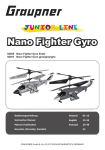
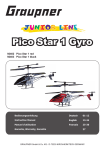
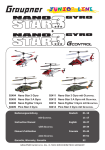
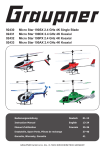
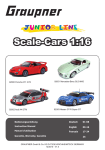
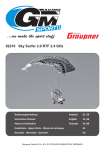
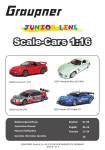
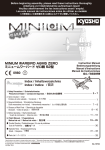
![Minium Citabria_P001 [Konvertiert]](http://vs1.manualzilla.com/store/data/006585447_3-fe7b6db82b655e204f379c9d210cf94d-150x150.png)
